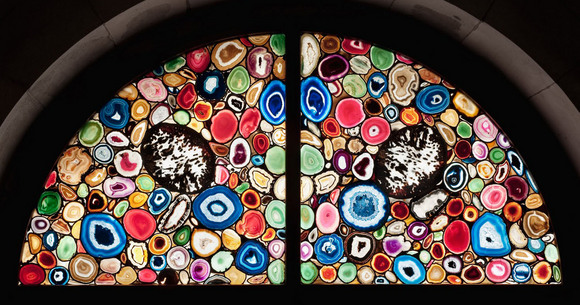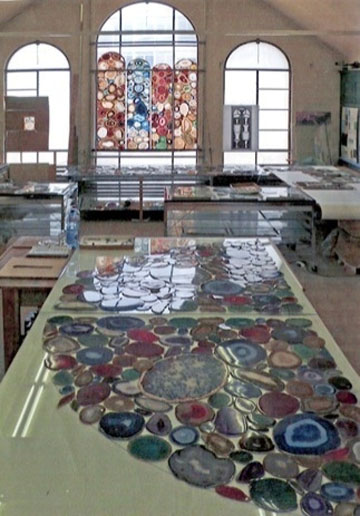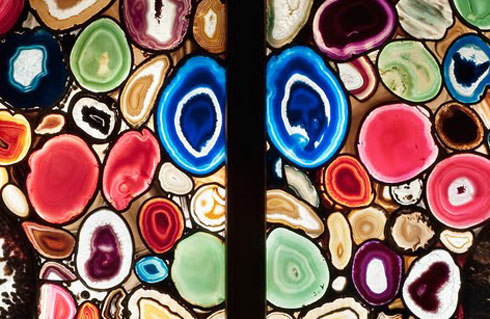March 17, 2010
Sigmar Polke at Grossmünster
A recent blog post from P.M. Doolan's ThinkShop about Sigmar Polke's Stained Glass Windows, with several images. I'd heard of these windows from the 2008 New Yorker article Many-Colored Glass, but the windows were not complete at that time.
This is an all-agate slice window, one of several by Polke in the church. I still haven't seen any decent shots of the windows in an architectural setting.
click to see larger image in new window

photo from a press kit released by the Grossmünster
This same window was pictured, while still on the bench in process, as part of the slideshow for the New Yorker article. It's interesting to see the contrast, and to see some of the other agate windows in the background finished but in the studio, pre-installation.

PHOTOGRAPH: Urs Rickenbach, Glas Mäder & Co., Zürich
Read more: New Yorker Slideshow
A detail
 .
.
One question I have about this window is a technical one. Most of the agate slices made for trade, especially the ones with bright and deeply saturated blues and pinks, are dyed with aniline dyes, and are not lightfast. That is, the colors will fade or change color over prolonged exposure to sunlight. I can only assume that the makers of this window know this and stayed away from the artificially dyed agate. I don't know enough about it to tell from the photographs alone. Time will tell.
When I first mentioned the New Yorker article in a blog post in May of 2008, I referred to it as "maddening". It's nearly 2 years later and I stick by that assessment. Why? To start with, Peter Schjeldahl's prose style can be pretty tortured. While I may well agree with some of his assertions, most are written in so roundabout a manner that I can't tell if I agree or not. It comes off as little more than art critical blathering.
One example -
The literally paradoxical, if not quite heretical, results of these two projects pose a question of whether, in Christian Europe today, art on celebrated artists’ terms has risen to equality with religion or if religion has sunk to the level of mere art.
I can't quite tell what is more convoluted here, the idea that is being presented or the prose style that is presenting it. Mostly, I still feel as I did in 2008, that it's not even worth my time to try to do a point by point rebuttal of those things I disagree with, since the general air of the article is one of condescension - that the New Yorker would not even be covering such an art form ("if it is an art form", says Schjeldahl), if the two leading painters of the day were not currently involved in these stained glass projects. Why bother?
Posted by Tom at March 17, 2010 10:21 AM